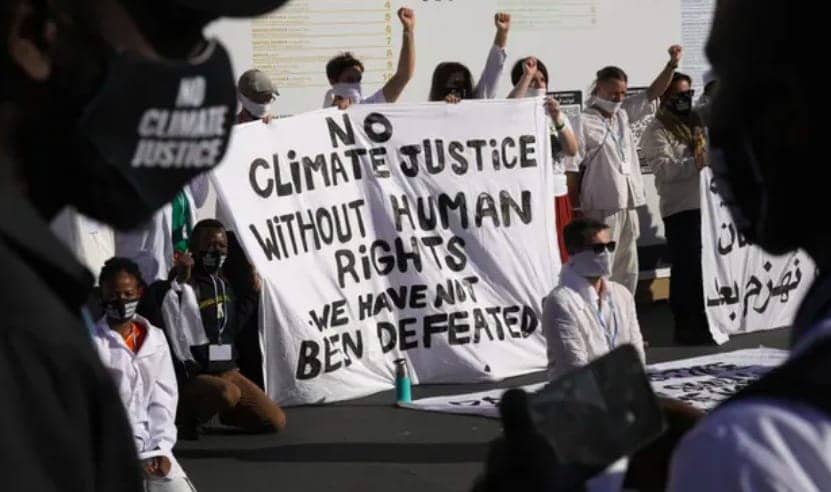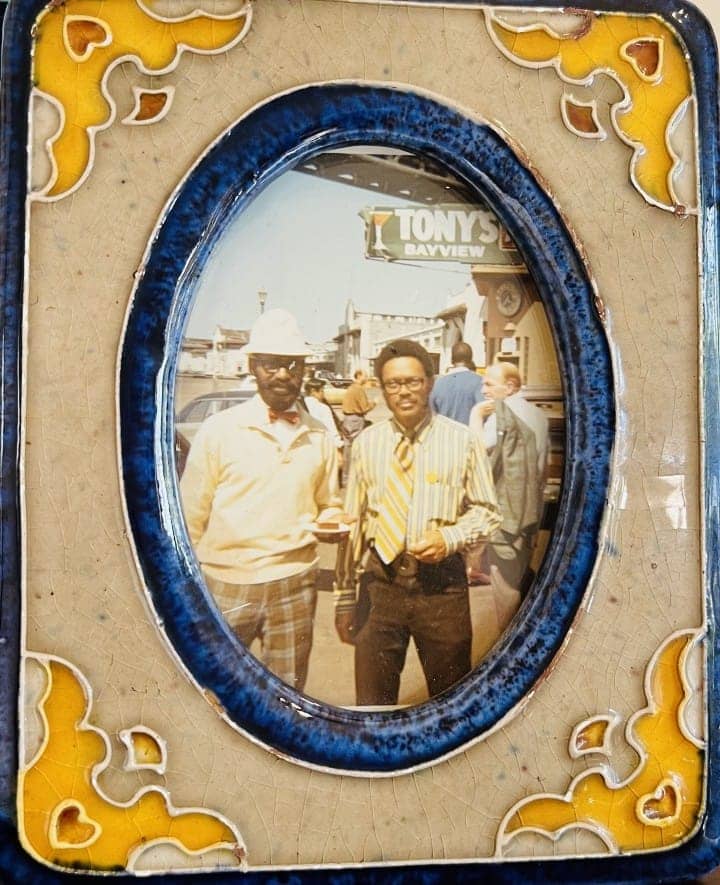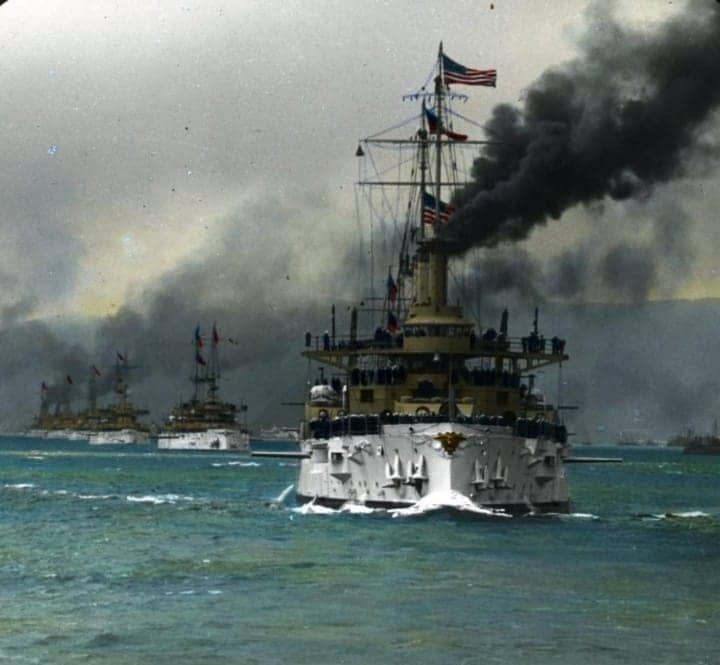
Heeding the clarion call for climate reparations
by Ahimsa Porter Sumchai, MD
“The air we breathe, the food we eat, the water we drink – indeed our health, wellbeing and survival all depend on a clean, healthy and sustainable environment,” said ASG Brands Kehris, United Nations Office of the High Commissioner for Human Rights.
On Oct. 8, 2021, the global environmental health and justice movement soared to new heights when the United Nations Human Rights Council adopted a historic resolution recognizing a clean, healthy and sustainable environment as a human right.
The hard fought adoption of UN Resolution 48-13 followed a momentous year for environmental justice when President Joe Biden issued an Executive Order Protecting Public Health and the Environment and Restoring Science to Tackle the Climate Crisis on Jan. 20, 2021.
“This form of environmental racism poses serious and disproportionate threats to the enjoyment of several human rights of it’s largely African American residents, including the right to equality and non-discrimination, the right to life, the right to health, the right to an adequate standard of living and cultural rights.”
Earlier that year, on March 2, 2021, the UN Human Rights Council issued a condemnation of “environmental racism” in response to a government decision to cite a highly polluting industry in a predominantly Black corridor along the Mississippi River lined with over a hundred refineries and petrochemical plants. EPA data documented the nation’s highest cancer risks from air pollution in Louisiana’s “Cancer Alley.”
Law professor Maxine Burkett coined the term “climate reparations” as “the understanding of climate change as a monumental injustice that needs to be addressed through law and policy.” In examining the past, present and future of climate reparations the recalculation of global debt must account for all that was stolen through slavery and colonialism and lives shortened and lost due to environmental injustice.

The latest UN climate reports highlight how communities that contribute the least to climate change suffer the most – Climate Change 2022: Impacts, Adaptation and Vulnerabilities.
Scientists on the UN Intergovernmental Panel on Climate Change argue 3.5 billion people – roughly 45% of the world’s population – live in regions of high vulnerability to climate change; the vast majority live in regions with the world’s lowest carbon emissions!
Climate reparations dominated the UN Climate Change Summit in Egypt this November as negotiations centered on loss and damages. Developing nations and overburdened communities demand help cutting emissions, adapting to climate change – and compensation for damages! Three key demands made by the Global South agreed to by US President Joe Biden and the European Union are:
- Increased climate finance grants
- Increased funding for climate adaptation
- Compensation for loss and damage suffered by frontline communities
Bayview Hunters Point (BVHP) is a historically African American community located in heavily industrialized southeast San Francisco on a promontory extending into San Francisco Bay. The rich legacy of racial, ethnic and cultural diversity of the region originated 10,000 years ago when the “First People” cultivated its tidal wetlands – the Ramaytush Ohlone.
Spanish missionaries colonized the promontory in the 1770s and by the 1850s a “gold rush” of diversification drove Chinese shrimp merchants, Italian cattle ranchers and wealthy white real estate moguls into the region. By 1869 “The World’s Greatest Shipping Yard” had been established by the Hunter brothers – who lived in a mansion on Oakdale Avenue in modern day Hunters Point.
‘Speak softly but carry a big stick!’
President Theodore Roosevelt’s use of this African proverb as a motto is best exemplified by the San Francisco Bay arrival of the “Great White Fleet” on May 6, 1908, enroute to “The World’s Greatest Shipping Yard” at the Hunters Point drydocks. Following maintenance and refueling, on July 7, 1908, the armada of 16 gold gilded battleships departed Hunters Point on a Tour de Force around the world.

US entry into World War II in 1941 marked the Atomic Age – an era of widespread chemical and radiation contamination of the Hunters Point Naval Shipyard (HPNS) and its adjoining neighborhoods. The great migration of African Americans – included my grandparents – who journeyed from Texas and Louisiana to work in post World War II HPNS.
The shipyard’s closure in 1974 prompted a severe economic downturn. Segregation landlocked African Americans into San Francisco’s southeast corner in populations as high as 60% via housing discrimination, blight and racially restrictive covenants compounded in later years by redevelopment, displacement and job loss as markets shifted from skilled labor to the service sector.
The role of redevelopment in the displacement of the African American population in southeast San Francisco has been likened to ethnic cleansing. Redevelopment projects became a neighborhood focus in the 1990s and continue to play a divisive role in community and government relations. The 2010 Shipyard/Candlestick Redevelopment Plan incorporates 1,300 acres of residential, commercial and industrial land.

Modern day BVHP has been radically transformed by gentrification. “Negro removal” was wildly successful. According to 2010 census data African Americans comprised 24% of the population in the region designated South Central Bayview Hunters Point. Census data in 2020 document the African American population has dwindled to 11% to match the white population. Asians and Pacific Islanders comprise 48% of the population while Hispanics constitute 27%.
The Oct. 24, 1988, Defense Authorization Base Realignment & Closure Act – Public Law 100-526 is the congressionally authorized process used by the Department of Defense to coordinate the transfer of military installations into civilian reuse.
In 1989 EPA designated HPNS a Federal Superfund site, assigning it a Hazard Ranking Score of 80 and placing it atop the National Priorities List of the nations most contaminated properties. The Naval Radiological Defense Laboratories operated as a campus along the shipyard’s southern shoreline from 1946 to 1969.
In 1955, while residents lived in private homes, public housing and historic mansions within feet of a broken chain metal fence at the western border of the base, the Navy began dumping radioactive waste into a 46 acre unlined industrial landfill and radioactive metal slag along the western panhandle area.

The Parcel E-2 Industrial Landfill is the subject of an investigation by the San Francisco Superior Court Civil Grand Jury (CGJ) released on June 1, 2022. The CGJ report reinforces findings of the San Francisco Climate and Health Profile that ranks neighborhoods on a scale of one through five based on resilience to climate change.
Echoing the global findings of UN scientists, BVHP ranked number one for risk of floods, landslides and heat vulnerability. Twenty seven percent of the region is at risk of environmental contamination. The EPA Superfund Site Cumulus for the Hunters Point Naval Shipyard lists 25 pages of chemicals and radionuclides of concern.
Many of these chemicals are being detected by the Hunters Point Community Biomonitoring Program in urinary screenings conducted on residents and workers within the one mile perimeter of the naval base. The findings of the Civil Grand Jury validate chemical and cancer clusters geospatially mapped by HP Biomonitoring.
Slow violence at the Hunters Point Naval Shipyard
“Military bases are extremely polluted, often contaminated with industrial wastes along with the various chemical, biological and nuclear weapons of war. Today many former bases are converted to civilian use, a process requiring extensive remediation.
“The reuse of military bases involves extracting toxic sediments as well as the sedimented histories of war and military violence … Slow violence emphasizes the dispersed and slow moving forms of environmental disaster and toxic suffering, expanding the spatialities and temporalities by which we might understand environmental injustice,” writes Lindsey Dillon, Ph.D., “War’s Remains: Slow Violence and the Urbanization of Military Bases in California.”
In four years of operation, HP Biomonitoring has advanced environmental public health, amassed media acclaim and prestigious awards for pioneering achievements
The Hunters Point Community Biomonitoring Program launched in January of 2019 to offer low cost, accurate urinary toxic exposure and nutrient screenings to residents and workers within the one mile perimeter of the Hunters Point Naval Shipyard.
In four years of operation, HP Biomonitoring has advanced environmental public health, amassed media acclaim and prestigious awards for pioneering achievements in cross referencing and geospatial mappings of data derived from urinary screenings conducted at the point of exposure with detailed environmental health evaluations and historical data derived from Superfund site characterizations.
These findings are further amplified using environmental geographic information, mapping and tracking tools including the EPA EJScreen, CalEnviroScreen 4.0, BAAQMD Interactive Mapping and Pollution Complaints, SaTscan cluster mapping tool and the BVHP IVAN – Identifying Violations Affecting Neighborhoods, www.bvhp-ivan.org.
IVAN operates as a community based environmental reporting and enforcement tool designed to connect residents with government agencies and environmental regulators responsible for addressing and resolving serious and chronic environmental offenses. IVAN is operated by Greenaction for Health & Environmental Justice. Complaints are reviewed at a monthly EJ Task Force. The IVAN posts real time data from eight air monitors installed in BVHP and issues Air-Quality alerts from the Marie Harrison Bayview Air Monitoring Network.
The Hunters Point Community Toxic Registry enshrines the highest mission, cumulative skills, knowledge and abilities of partners dedicated to establishing cause and effect relationships between environmental exposures and expressions of disease and delivery of state of the art interventions, medicolegal referrals and advocacy to heal a wounded community.
The Mission of the Hunters Point Biomonitoring Foundation is the establishment of the Hunters Point Community Toxic Registry.
The growing impact of community exposures to landfills, toxic dumps, industrial waste sites, polluting industries and military installations drives the environmental public health initiative to institute toxic registries capable of enrolling vulnerable populations faced with life threatening exposures to toxicants with generational impacts on health, safety and life expectancy.
Toxic registries have been established in toxic tort settlements offering a spectrum of medical, legal, occupational and social services delivered by a medical supervised institute that monitors progress and outcomes for generations. Toxic registries operate in Flint, Mich., Camp Lejeune and for first responders exposed to toxic dust and debris enrolled by the World Trade Center Health Program. The VA Environmental and Burn Pit Registries are the nation’s largest. Atomic Bomb survivor registries in Japan offer valuable insight into care of the world’s largest radiation exposed populations.
The community-led initiative to establish the Flint Lead Exposure Registry was adopted by the Centers for Disease Control after a Flint resident appointed to the Flint Water Taskforce proposed a toxic registry in 2016. The Congressional Water Infrastructure Improvements Act offered a four year grant to the CDC to create the Flint Lead Exposure Registry.
In 2017 the Michigan Department of Public Health funded the initiative to institute a toxic registry. In partnership with the Greater Flint Health Coalition, Michigan State University was issued the Flint Registry grant for the term 2017–2021.
The Mission of the Hunters Point Biomonitoring Foundation is the establishment of the Hunters Point Community Toxic Registry. The most valuable delivery of HP Biomonitoring’s pioneering work is the creation of a successful model of community exposure research transferrable and directly applicable to environmental justice impacted communities across the nation.
Simple criteria for enrollment in a toxic registry are risk and proof of exposure to an environmental release – either acute or chronic. The findings of the Hunters Point Community Biomonitoring Program show the intensity and severity of exposure are factored by duration, proximity and age but chemicals of concern, including products of nuclear fission, are predictably detected in residents and workers within the half mile perimeter of the Hunters Point Naval Shipyard.
SF Bay View Health and Environmental Science Editor Ahimsa Porter Sumchai, MD, PD, founder and principal investigator for the Hunters Point Community Biomonitoring Program, founding chair of the Hunters Point Naval Shipyard Restoration Advisory Board’s Radiological Subcommittee and contributor to the 2005 Draft Historical Radiological Assessment, can be reached at AhimsaPorterSumchaiMD@Comcast.net. Dr. Sumchai is medical director of Golden State MD Health & Wellness, a UCSF and Stanford trained author and researcher, and a member of the UCSF Medical Alumni Association Board of Directors.





